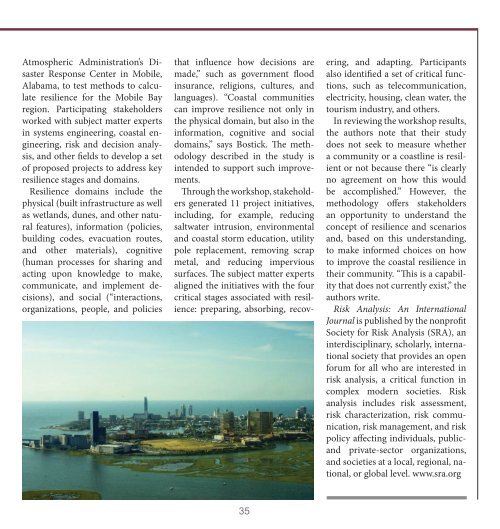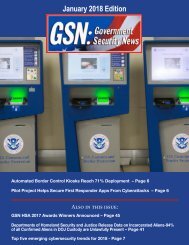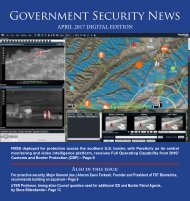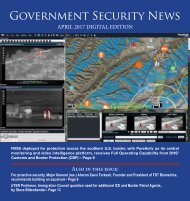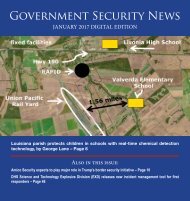GSN_Nov-Dec_FINAL_Yumpu
You also want an ePaper? Increase the reach of your titles
YUMPU automatically turns print PDFs into web optimized ePapers that Google loves.
Atmospheric Administration’s Disaster<br />
Response Center in Mobile,<br />
Alabama, to test methods to calculate<br />
resilience for the Mobile Bay<br />
region. Participating stakeholders<br />
worked with subject matter experts<br />
in systems engineering, coastal engineering,<br />
risk and decision analysis,<br />
and other fields to develop a set<br />
of proposed projects to address key<br />
resilience stages and domains.<br />
Resilience domains include the<br />
physical (built infrastructure as well<br />
as wetlands, dunes, and other natural<br />
features), information (policies,<br />
building codes, evacuation routes,<br />
and other materials), cognitive<br />
(human processes for sharing and<br />
acting upon knowledge to make,<br />
communicate, and implement decisions),<br />
and social (“interactions,<br />
organizations, people, and policies<br />
that influence how decisions are<br />
made,” such as government flood<br />
insurance, religions, cultures, and<br />
languages). “Coastal communities<br />
can improve resilience not only in<br />
the physical domain, but also in the<br />
information, cognitive and social<br />
domains,” says Bostick. The methodology<br />
described in the study is<br />
intended to support such improvements.<br />
Through the workshop, stakeholders<br />
generated 11 project initiatives,<br />
including, for example, reducing<br />
saltwater intrusion, environmental<br />
and coastal storm education, utility<br />
pole replacement, removing scrap<br />
metal, and reducing impervious<br />
surfaces. The subject matter experts<br />
aligned the initiatives with the four<br />
critical stages associated with resilience:<br />
preparing, absorbing, recovering,<br />
and adapting. Participants<br />
also identified a set of critical functions,<br />
such as telecommunication,<br />
electricity, housing, clean water, the<br />
tourism industry, and others.<br />
In reviewing the workshop results,<br />
the authors note that their study<br />
does not seek to measure whether<br />
a community or a coastline is resilient<br />
or not because there “is clearly<br />
no agreement on how this would<br />
be accomplished.” However, the<br />
methodology offers stakeholders<br />
an opportunity to understand the<br />
concept of resilience and scenarios<br />
and, based on this understanding,<br />
to make informed choices on how<br />
to improve the coastal resilience in<br />
their community. “This is a capability<br />
that does not currently exist,” the<br />
authors write.<br />
Risk Analysis: An International<br />
Journal is published by the nonprofit<br />
Society for Risk Analysis (SRA), an<br />
interdisciplinary, scholarly, international<br />
society that provides an open<br />
forum for all who are interested in<br />
risk analysis, a critical function in<br />
complex modern societies. Risk<br />
analysis includes risk assessment,<br />
risk characterization, risk communication,<br />
risk management, and risk<br />
policy affecting individuals, publicand<br />
private-sector organizations,<br />
and societies at a local, regional, national,<br />
or global level. www.sra.org<br />
35


